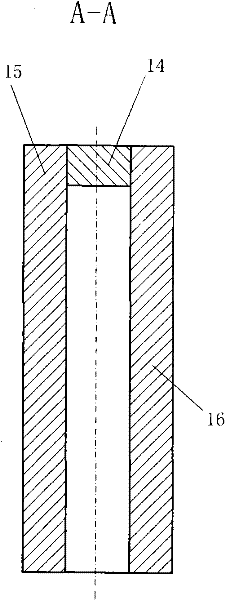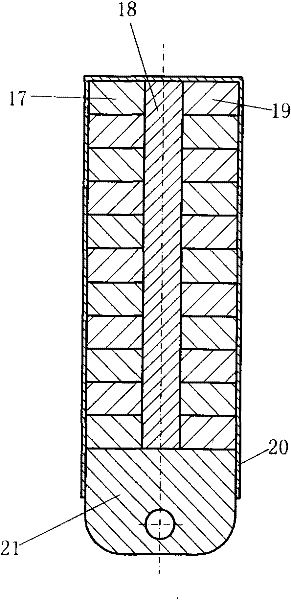Magnetic lock
A magnetic lock and lock housing technology, applied in the field of magnetic locks, can solve the problems of poor anti-theft performance, damage resistance and environmental adaptability, which are not as good as pin locks, and inconvenient use.
- Summary
- Abstract
- Description
- Claims
- Application Information
AI Technical Summary
Problems solved by technology
Method used
Image
Examples
Embodiment 1
[0042] Embodiment one: the first structure of the magnetic lock, such as Figure 9 Figure 10 Show. Its magnetic lock core adopts the first kind of magnetic lock core, and its key adopts the first kind of magnetic key. Adopting described buckle mechanism is: lock hook 38 vertically passes through the center of buckle 39 and connects with it, the bottom of lock hook 38 is covered with spring 37, and buckle 39 has grab hooks drooping left and right. Insert the lower part of the lock hook 38 into the blind hole in the middle part of the non-magnetic upper plate 14 of the first type of magnetic lock core, and form a sliding fit with the blind hole, and divide the left and right drooping hooks of the buckle 39 into the first type. The left and right sides of the magnetic lock core can respectively be engaged with the clasp at the left non-magnetic bar 4 outer ends of the first kind of magnetic lock core and the clasp at the right non-magnetic bar 10 outer ends. Lock housing 36 s...
Embodiment 2
[0045] Embodiment two: the second structure of the magnetic lock, such as Figure 13 Figure 14 Show. Its magnetic lock core adopts the second magnetic lock core, and its key adopts the second magnetic key. The buckle mechanism is as follows: the lock hook 42 vertically passes through the buckle 40 and connects with it, and the spring 43 is placed on the lower part of the lock hook 42, and the buckle 40 has a left drooping hook. Insert the lower part of the lock hook 42 into the blind hole on the left side of the non-magnetic upper plate 29 of the second type of magnetic lock core, and form a sliding fit with the blind hole, and place the drooping hook on the left side of the buckle 40 in the second type. The left side of the magnetic lock core, and can engage with the clasp on the non-magnetic rod 25 outer end of the second magnetic lock core. The bottom of lock case 41 is connected with the bottom of the left side of the second magnetic lock core, and the hole on the top ...
Embodiment 3
[0048] Embodiment three: the third structure of the magnetic lock, such as Figure 17 Show. Magnetic lock core 1 uses described second kind of magnetic lock core, and the upper end of its non-magnetic bar is an inclined plane, and the non-magnetic bar here for short is dead bolt; Left support plate 48, right support plate 43 are placed in magnetic lock core 1 The left and right sides of the latch 49 respectively pass through the hole on the top of the left support plate 48, the hole on the top of the right support plate 43, and form a sliding fit with the hole, the oblique notch on the latch 49 and the dead bolt Correspondingly, the right end of the latch 49 has a slope to the left; the spring 44 is enclosed within the right portion of the latch 49 and is blocked between the right side of the right support plate 43 and the retaining ring with a retaining ring 50, and the retaining ring 50 is connected with the latch 49, But the right end slope is leaked out; the breach of the...
PUM
 Login to View More
Login to View More Abstract
Description
Claims
Application Information
 Login to View More
Login to View More - R&D
- Intellectual Property
- Life Sciences
- Materials
- Tech Scout
- Unparalleled Data Quality
- Higher Quality Content
- 60% Fewer Hallucinations
Browse by: Latest US Patents, China's latest patents, Technical Efficacy Thesaurus, Application Domain, Technology Topic, Popular Technical Reports.
© 2025 PatSnap. All rights reserved.Legal|Privacy policy|Modern Slavery Act Transparency Statement|Sitemap|About US| Contact US: help@patsnap.com



